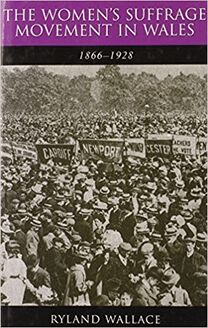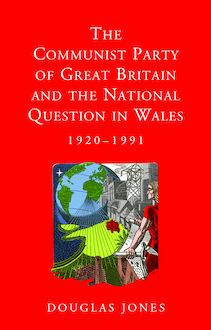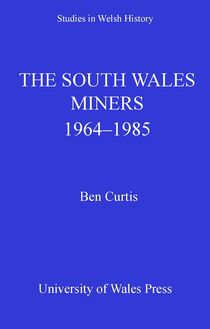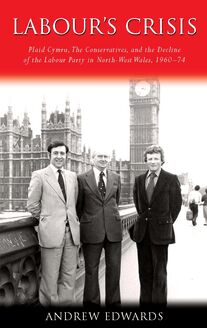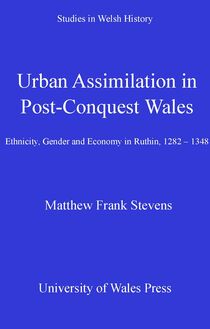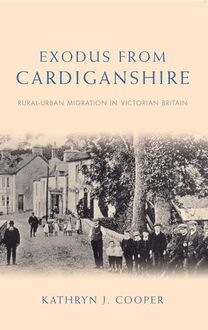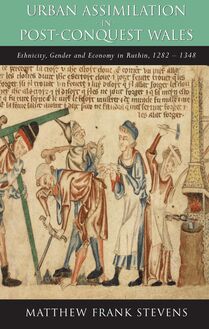Urban Assimilation in Post-Conquest Wales , livre ebook
125
pages
English
Ebooks
2010
Vous pourrez modifier la taille du texte de cet ouvrage
Obtenez un accès à la bibliothèque pour le consulter en ligne En savoir plus
Découvre YouScribe et accède à tout notre catalogue !
Découvre YouScribe et accède à tout notre catalogue !
125
pages
English
Ebooks
2010
Vous pourrez modifier la taille du texte de cet ouvrage
Obtenez un accès à la bibliothèque pour le consulter en ligne En savoir plus
Publié par
Date de parution
30 mars 2010
Nombre de lectures
2
EAN13
9781783164011
Langue
English
This book uses, principally but not only, a case study of the Denbighshire town of Ruthin to discuss both the significance of Englishness versus Welshness and of gender distinctions in the network of small Anglo-Welsh urban centres which emerged in north Wales following the English conquest of 1282. It carefully constructs an image of the way in which townspeople's everyday lives were influenced by their ethnic background, gender, wealth and social status. In this manner it explores and explains the motivations of English and welsh townspeople to work together in the mutual pursuit of prosperity and social stability.
Publié par
Date de parution
30 mars 2010
EAN13
9781783164011
Langue
English
URBAN ASSIMILATION IN POST-CONQUEST WALES
ETHNICITY, GENDER AND ECONOMY IN RUTHIN, 1282–1348
by
MATTHEW FRANK STEVENS
Published on behalf of the University of Wales
© Matthew Frank Stevens, 2010
All rights reserved. No part of this book may be reproduced in any material form (including photocopying or storing it in any medium by electronic means and whether or not transiently or incidentally to some other use of this publication) without the written permission of the copyright owner except in accordance with the provisions of the Copyright, Designs and Patents Act 1988 or under the terms of a licence issued by the Copyright Licensing Agency Ltd, Saffron House, 6–10 Kirby Street, London, EC1N 8TS. Applications for the copyright owner’s written permission to reproduce any part of this publication should be addressed to The University of Wales Press, 10 Columbus Walk, Brigantine Place, Cardiff, CF10 4UP.
www.uwp.co.uk
British Library Cataloguing-in-Publication Data. A catalogue record for this book is available from the British Library.
ISBN 978-0-7083-2249-9 e-ISBN 978-1-78316-401-1
The right of Matthew Frank Stevens to be identified as author of this work has been asserted by him in accordance with Sections 77, 78 and 79 of the Copyright, Designs and Patents Act 1988.
Cover illustration: Blacksmith’s wife forging nails. Image taken from Holkham Bible Picture Book © The British Library Board. Add. 47682, f.31.
SERIES EDITORS’ FOREWORD
Since the foundation of the series in 1977, the study of Wales’s history has attracted growing attention among historians internationally and continues to enjoy a vigorous popularity. Not only are approaches, both traditional and new, to the study of history in general being successfully applied in a Welsh context, but Wales’s historical experience is increasingly appreciated by writers on British, European and world history. These advances have been especially marked in the university institutions in Wales itself.
In order to make more widely available the conclusions of original research, much of it of limited accessibility in postgraduate dissertations and theses, in 1977 the History and Law Committee of the Board of Celtic Studies inaugurated this series of monographs, Studies in Welsh History. It was anticipated that many of the volumes would originate in research conducted in the University of Wales or under the auspices of the Board of Celtic Studies, and so it proved. Although the Board of Celtic Studies no longer exists, the University of Wales continues to sponsor the series. It seeks to publish significant contributions made by researchers in Wales and elsewhere. Its primary aim is to serve historical scholarship and to encourage the study of Welsh history.
ACKNOWLEDGEMENTS
This book has been a very long time in the making. It began its life as my University of Wales, Aberystwyth, Ph.D. thesis, researched and written between 2001 and 2005 under the supervision of Professor Phillipp R. Schofield, whose encouragement and genuine interest in my research have profoundly shaped my desire to discover the ordinary lives of the peoples of medieval Wales and England. The core of the text presented here remains that of my Ph.D. thesis, and so the acknowledgements included at the front of that document have been reproduced below. Additionally, I must acknowledge the support of those who helped me along the sometimes arduous path which has transformed my thesis, through several rewrites and the addition of much new research, into the book presented here – which nonetheless still bears the hallmarks of a student learning to write history. These include the Economic History Society, without whose generous financial support I would never have got underway, everyone at the University of Oxford who made me feel so welcome during my time there, and the very good friends I have been fortunate to know since moving to the city and University of London, where I have been kindly employed by the Centre for Metropolitan History. In particular, I must thank Mark Merry for his help with the maps, Guy Geltner and Hannes Kleineke for their comments on parts or all of early draft manuscripts and, above all, Ralph Griffiths who so generously offered meticulous and invaluable advice on each draft of this book, and who has done so much to make my prose more intelligible. All remaining mistakes are, of course, my own.
London March 2009
PH.D. ACKNOWLEDGEMENTS
Where can one begin in acknowledging his debts to all those who have offered support and guidance in a project which has taken years to complete? Most immediate is the huge debt I owe to my supervisor, Professor Phillipp Schofield of the University of Wales, Aberystwyth, who has been both knowledgeable and understanding throughout, having a good sense of humour and a great deal of patience. Similarly patient and helpful has been Sarah Powis, whose efforts to help me resolve countless issues of grammar and spelling have been a blessing to me. More broadly, I need to thank both my American friends (most particularly Warren Love, Matthew Bernosky, Jason Msadoques and Howard Simmerman, whose campaigns and adventures have always inspired me) and my closest British friends (Jamie Tedford, Richard Jones and Richard Cordle, among many others) who have kept me sane and made me feel welcome over the last eight years. Likewise, I have always appreciated the support given to me by Patricia Henninger, who shares my interest in places abroad. Lastly and most importantly, I am grateful for the unflagging love and guidance of my mother and father, the latter of whose advice – ‘whatever makes you happy son’ – is the most straightforward and valuable I have ever received (and by the way, this makes me happy).
Aberystwyth
CONTENTS
SERIES EDITORS’ FOREWORD
ACKNOWLEDGEMENTS
PH.D. ACKNOWLEDGEMENTS
LIST OF FIGURES
LIST OF TABLES
ABBREVIATIONS
PLACE NAMES AND PERSONAL NAMES
DEFINITIONS
Introduction
Part 1: Men as Property Holders and the Social Elites
I Population, Property and Wealth
II Status and Dominance
Part 2: Women in the Borough: Access to Capital and Occupation
III Curial Representation, Brewsters and Women with High Levels of Investment Capital
IV Bakeresses and other Skilled Workers: Women with Access to Moderate Levels of Investment Capital
V Cloth Workers, Forestallers, Service Women: Women with Little or No Investment Capital
Part 3: Men as Workers: Occupation and Mobility
VI Male Occupation and Mobility
Conclusion
BIBLIOGRAPHY
Map 2. Medieval Ruthin
FIGURES Map 1 The marcher lordships of north-east Wales in the early fourteenth century Map 2 Medieval Ruthin 3.1 Ruthin’s female brewers per biannual assize list, 1312–21 4.1 Number of Ruthin bakers amerced per biannual assize, 1306–42 4.2 Timeline of Chamberlain family’s baking amercements 4.3 New and departing female bakers 5.1 Ruthin’s regrators and forestallers, 1312–21 5.2 Rape and abduction in Dyffryn Clwyd, 1320–69 5.3 Men charged in connection with rape or abduction, 1320–69 5.4 Welsh and English women in borough occupations, relative quantities
TABLES 1.1 Ruthin property owners as in the 1324 rental, by rent paid 1.2 Ruthin’s common burgage divisions in 1324 1.3 Wealth ranking of most significant property accumulators in 1324 2.1 Great court of Ruthin jurors, 1312–21 2.2 Random sample of non-juror court activities, 1312–21 2.3 Jurors compared with non-jurors, 1312–21 2.4 Frequent borough court of Ruthin debt litigants, 1312–21 2.5 Borough court of Ruthin debt and unjust detention plaintiffs, 1312–21 2.6 Elites by indicator 3.1 Women in Ruthin’s courts, 1312–21 3.2 Reasons for ‘entry-appearances’, borough court of Ruthin, 1312–21 3.3 Women in unjust detention and violence cases, borough court of Ruthin, 1312–21 3.4 ‘Absolute-appearances’ in the borough court of Ruthin, 1312–21 3.5 All brewers, Ruthin, 1312–21 3.6 Group 3 brewsters, Ruthin, 1312–21 4.1 Female bakers of Ruthin, 1306–42 4.2 Ruthin’s independent/explicitly named skilled craftswomen, 1312–21 5.1 Ruthin’s female victuallers, cloth workers and service women, 1312–21 6.1 Male occupational by-names from the borough court of Ruthin, 1312–21: overview of male occupation data 6.2 Male occupational by-names from the borough court of Ruthin, 1312–21: ecclesiastical workers 6.3 Male occupational by-names from the borough court of Ruthin, 1312–21: officers and staff of governance 6.4 Male occupational by-names from the borough court of Ruthin, 1312–21: skilled craftsmen and merchants 6.5 Male occupational by-names from the borough court of Ruthin, 1312–21: manual labourers and servants
ABBREVIATIONS AC Archaeologia Cambrensis AHR Agricultural History Review BBCS Bulletin of the Board of Celtic Studies Black Book J. W. Willis-Bund (ed.), The Black Book of St David’s (London, 1902) BL British Library Caernarvon Court Rolls G. Jones and H. Owen (eds), Caernarvon Court Rolls, 1361–1402 (Caernarfon, 1951) CC Continuity and Change DHST Denbighshire Historical Society Transactions * Dyffryn Clwyd Database R. R. Davies and Ll. B. Smith (eds), machine readable database, The Dyffryn Clwyd Court Roll Database, 1294–1422 (Aberystwyth, 1995) EconHR The Economic History Review HWJ History Workshop Journal JBS Journal of British Studies JFH Journal of Family History JHG Journal of Historical Geography JIH Journal of Interdisciplinary History LHR Law and History Review NLW National Library of Wales PP Past and Present RMS Reading Medieval Studies THSC Transactions of the Honourable Society of Cymmrodorion ** TNA The National Archives TRHS Transactions of the Royal Historical Society UHist Urban History UHY Urban History Yearbook WHR Welsh History Review
PLACE NAMES AND PERSONAL NAMES
Place names have been modernized, except where used as surnames. Problem place names have been left in inverted commas.
Personal names generally take one of four forms: a Christian name and locational by-name, usually


